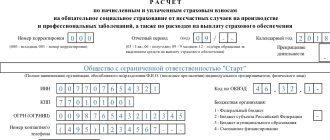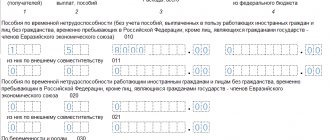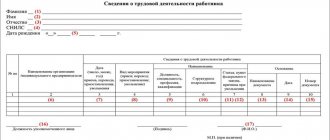Introductory information
Let us recall that the current RSV-1 form consists of six sections (see “New RSV-1 form: features of filling out and submitting calculations for the first half of 2015”). Each policyholder at the end of each reporting period (including 9 months) must fill out and submit as part of DAM-1:
- title page;
- Section 1 “Calculation of accrued and paid insurance premiums”;
- subsection 2.1 “Calculation of insurance premiums according to the tariff and additional tariff.”
The remaining sections of the form are filled out only if the relevant indicators are available.
Thus, Section 6 “Information on the amount of payments and other remuneration and the insurance experience of the insured person” is formed for each employee who was in an employment relationship with the insured, or with whom a civil law or copyright agreement was concluded, if during the last three months of the reporting period the employee received contributions or had information about his or her length of service. This conclusion follows from the provisions of paragraphs 3 and 27 of the Procedure for filling out the RSV-1, as well as the Rules for checking the RSV-1 (approved by order of the PFR board dated July 31, 2014 No. 323r).
Thus, section 6 must be included in the RSV-1 for 9 months, if for the period from July to September the insurer accrued payments to at least one employee or during this period the employee retained length of service (for example, he was on leave without pay or maternity leave). If there is information about payments only for previous periods from the beginning of the year (for example, if the only employee was fired in June), then section 6 is not formed.
Section 6 consists of subsections 6.1 - 6.8. Let's look at some features of filling them out.
Deadline for issuing a copy of Section 6 of the RSV-1
An extract (copy) from section 6 of the RSV-1 must be given to employees within the same period as the delivery of the RSV-1. That is, no later than the following dates:
- copies of section 6 of RSV-1 for the nine months of 2021 - issue to employees no later than November 15, 2021, if the calculation is submitted “on paper” or no later than November 21, 2021 (November 20 is a day off), if the calculation is submitted electronically .
- copies of section 6 of RSV-1 for 2021 - issue to employees no later than February 15, 2021, if the calculation is submitted “on paper” or no later than February 20, 2021, if the calculation is submitted electronically.
Read also
12.01.2018
Subsection 6.1 “Information about the insured person”
Columns 1 - 3 of this subsection indicate full name. employee, and in column 4 - the insurance number of the individual personal account of the insured person (SNILS).
In the “Information about the dismissal of the insured person” field, you should put o if the information is provided for an employee who resigned in the last three months of the reporting period. This means that this mark must be included in the calculation for 9 months if the employee with whom the employment contract was concluded quit in July, August or September.
Structure and rules for filling out the document
The RSV form for 2021 consists of a title page and 3 sections:
1. SECTION 1 – summary data on insurance premiums and 9 appendices. 2. SECTION 2 - for heads of peasant farms and 1 appendix. 3. SECTION 3 - personalized information about each employee.
Each section includes several subsections and appendices to them. At first glance, it seems that the DAM report is quite voluminous. In fact, the work of filling it out will not be so difficult, since not all sections need to be filled out. Therefore, first we will find out who exactly needs to fill out which sections and subsections.
TITLE PAGE. Completed by all policyholders without exception.
SHEET “Information about an individual who is not an individual entrepreneur.” Individual entrepreneurs and organizations do not fill out this sheet. It is filled out by individuals for hired workers.
Section 1, subsections 1.1 and 1.2 of appendices 1 and 2 to section 1, section 3 - are filled out and submitted by all LLCs and individual entrepreneurs paying income to individuals during the reporting quarter.
Section 2 and Appendix 1 to Section 2 are filled out by the heads of peasant farms.
Subsections 1.3.1; 1.3.2; 1.4 of Appendix 1 to Section 1 are completed if an individual entrepreneur or organization charges insurance premiums at additional rates.
Applications 5; 6; 7; Section 1 is filled out by individual entrepreneurs or LLCs, which apply reduced rates when calculating insurance premiums.
Appendix 8 to Section 1 is completed in cases of payment of income to foreign employees or stateless employees.
Appendix 9 to Section 1 must be completed if in the reporting quarter income was paid to students who worked in student teams.
Appendices 3 and 4 to Section 1 are filled out by individual entrepreneurs or LLCs that paid benefits in the reporting quarter.
Having selected the sections relevant to your activity, you can begin filling them out.
The rules for filling out the document are as follows:
1. Each field of the report contains a specific indicator; it cannot be supplemented with other information.
2. Pages are numbered in the corresponding cells as follows: “001”, “002”... “033”.
3. There are two fields for recording a decimal fraction: the first contains the whole part, and the second contains the remainder.
4. Text fields are filled in from left to right, starting from the first window.
5. Cost indicators are indicated in rubles and kopecks, separated by a dot.
6. When filling out a document on a computer, use the Courier New font (16-18 point).
7. In the fields for quantitative and total indicators, enter “0” (“zero”). In other cases, for example, when there are no text indicators, a dash is placed in all familiar places in the field.
8. When filling out the calculation on a computer, there is no need to put zeros and dashes in the empty cells.
9. At the end of each page of the DAM you must put a signature and indicate the date of signing.
10. If there is a seal, it is placed on the title page.
Subsection 6.3 “Type of information correction”
This subsection indicates the type of information correction: initial, corrective or canceling.
If reporting is submitted for the first time, then you need to select the adjustment type “initial” (o). In this case, the fields “Reporting period (code)” and “Calendar year” in subsection 6.3 are not filled in.
The “corrective” field should be used if you need to clarify previously submitted information about the employee. If it is necessary to completely cancel information about the insured person, then select the “cancelling” field. When filling out sections 6 with the “correcting” or “cancelling” type, in the “Reporting period (code)” and “Calendar code” fields, you must indicate, respectively, the reporting period code and the year for which the information is being adjusted or canceled.
Sections 6 with the type of adjustment “corrective” or “cancelling” are presented together with Section 6 with the type “initial” for the reporting period for which the reporting deadline has arrived.
Note that the field with the type of adjustment should not be empty. If an accountant fills out RSV-1 calculations electronically, then he will definitely fulfill this requirement. Thus, when generating the current calculation of DAM-1 in the “Contour.ReportPF” service, the default adjustment type will be “initial”. If you need to fill out a “corrective” or “cancelling” form, then in the program you need to select the type of adjustment and the appropriate period.
For more information about the types of adjustments and how to reflect them in the DAM-1 calculation, see “How to correct an error in the DAM-1: filling out an updated calculation according to the new rules.”
RSV for 2021
Starting from the 2021 report, the form of calculation will change. The update of the current form was approved by order of the Federal Tax Service dated October 15, 2020 No. ED-7-11/751. In the new form, the indicator “Average headcount” appeared on the title page, and the old annual report on the average headcount was canceled.
The tariff codes and categories of insured persons were also supplemented and updated. Codes that have already been used since the first half of 2021 by SMEs and affected businesses have been added to the applications.
Codes for the IT sector - developers of electronics and electronic products - have also been added. Also, a special Appendix No. 5.1 to Section 1 was introduced for them, but it begins to operate from the calculation for the first quarter. In the report for 2021, you must fill out Appendix No. 5 to Section 1 for the last time.
Fill out the calculation for 2021 based on the results of the entire year - from January 1 to December 30. The tax office will wait until February 1, 2021.
Keep in mind that the day the report is due is determined differently:
- when submitted to the tax office - the day of delivery to the tax inspector and receipt of the stamp on the second copy;
- when sent by mail - the day the package of documents is received and stamped at the post office;
- when sending via TKS - the day on which the operator recorded the shipment.
The filling form was approved by order of the Federal Tax Service dated September 18, 2019 N ММВ-7-11/ [email protected] The procedure for filling out the report is standard. Indicate on the title page the correct reporting period code—“34” for the year and “90”—for reorganization or liquidation. In the “Calendar year” field, indicate the year for which you are submitting the calculation – 2021.
Subsection 6.6 “Information about corrective information”
Subsection 6.6 is filled out in the DAM-1 calculation with the “initial” adjustment type, if in the last three months of the reporting period the data that was presented in previous reporting periods were adjusted.
When adjusting information, data on the amounts of recalculation of insurance premiums are indicated in the following order:
- for reporting periods from the first quarter of 2014 - in column 3 of subsection 6.6;
- for the reporting periods 2010 - 2013 - in columns 4 and 5 of subsection 6.6. Let's give an example of filling out subsection 6.6 for the case when data for the first quarter of 2015 is corrected.
Please note: if subsection 6.6 contains information about adjustments, then along with the DAM-1 calculation for 9 months, corrective (cancelling) sections 6 of the calculation and (or) forms SZV-6-1, SZV-6-2, SZV must be submitted -6-4.
Subsection 6.6 must also be completed if corrective (cancelling) information for previous periods is provided in connection with the recalculation of contributions for already dismissed employees. In this case, in subsection 6.4 it is necessary to indicate only the category code of the insured person, and subsections 6.5, 6.7 and 6.8 do not need to be filled out.
DAM for the 1st quarter of 2021
The calculation of insurance premiums is submitted quarterly and includes information presented on an accrual basis. That is, the DAM for the first quarter includes all data from January 1 to March 31. The deadline for submitting the report in 2021 is April 30.
The DAM for the 1st quarter must be filled out on a standard form approved by order of the Federal Tax Service dated September 18, 2019 N ММВ-7-11/ [email protected]
The procedure for filling out the report for the 1st quarter is standard. Do not forget to indicate on the title page the correct reporting period code - “21” for the 1st quarter and “51” - for the 1st quarter during reorganization or liquidation. In case of deregistration of an individual entrepreneur (head of a peasant farm) - code “83”.
Codes in subsection 6.8
The remaining columns of subsection 6.8 (that is, columns 4 - 9) will be filled out using special codes that are given in Appendix No. 2 to the Procedure for filling out the RSV-1.
It is important to note that codes in columns 5 - 9 of subsection 6.8 need to be entered only if the employee is engaged in heavy, hazardous or other work that gives the right to early retirement. They do not need to be filled out if special working conditions are not documented, or if the employee’s employment in these conditions does not meet the requirements of current regulatory documents (clause 37.7 of the Procedure for filling out the RSV-1).
Column 4 “Territorial conditions”
The code in column 4 indicates that the territorial working conditions of the employee give him the right, in particular, to early assignment of a pension. For example, if an employee works in the Far North region, then in this column you need to enter the code “RKS”. If such an employee performs work full-time on a part-time basis, then it is necessary to additionally indicate the number of days actually worked that will be counted toward the “northern” length of service. And if the employee works part-time, then the amount of work during a given period must be reflected (for example, 0.75 of the rate). This is what column 4 of subsection 6.8 might look like:
If there are no special territorial working conditions, then column 4 is not filled in.
Column 5 “Special working conditions”
The code in column 5 shows that the employee worked under special working conditions that will allow him to retire early. For example, code “27-2” means that the employee is employed in difficult working conditions.
Column 6 “Bases”
The special code in column 6 indicates that the employee’s insurance period is calculated in a special manner. For example, the code “SEASON” must be entered if a person works in seasonal industries.
Column 7 “Additional information”
Using the code in column 7, certain periods in the employee’s work experience are highlighted. Here are the codes that are most often entered in this column:
| CHILDREN | Parental leave until the child reaches the age of one and a half years, granted to one of the parents |
| DECREE | Maternity leave |
| AGREEMENT | Work under civil contracts that extends beyond the billing period |
| DLOTPUT | Staying on paid leave |
| NEOPL | Vacation without pay, downtime due to the fault of the employee, unpaid periods of suspension from work (preclusion from work) |
| VRNETRUD | Period of temporary incapacity for work |
| QUALIFY | Off-the-job training |
| SUSPENDED | Suspension from work (preclusion from work) through no fault of the employee |
| SIMPLE | Downtime caused by the employer |
| ACCEPTANCE | Additional leave for employees combining work and study |
| NEOPLDOG | The period of work of the insured person under a civil law contract, payments and other remunerations for which are accrued in the following reporting periods |
As already mentioned, columns 5 to 9 of subsection 6.8 must be filled out if the employee is employed in work with special working conditions that give the right to early retirement (clause 37.7 of the Procedure for filling out the RSV-1). Does this mean that if an employee works in “regular” jobs and does not apply for early retirement, then when creating subsection 6.8, the accountant should leave column 7 empty? Accountants do not have a unanimous opinion on this issue.
Expert of the service “Kontur.Otchet PF” Elena Kulakova (on the Accounting Online forum she writes under the nickname KEGa) believes that under certain conditions, column 7 of subsection 6.8 must be filled out for those employees who do not have the right to early retirement.
Let's illustrate with an example. In the last three months of the reporting period, the employee received payments subject to insurance premiums (that is, columns 5 of lines 401 - 403 of subsection 6.4 are not equal to zero). For example, this subsection might look like this:
Since in this case the entire period will be included in the employee’s insurance period, it is not necessary to enter any code in column 7 of subsection 6.8.
But it is possible that for the last three months of the reporting period (or for one or two of the specified three months) the employee was not accrued payments. For example, if he was sick or was on parental leave for up to one and a half years. In this case, in subsection 6.4 there will be empty columns 4 and 5 for the corresponding line (for example, line 403 of subsection 6.4 of the RSV-1 calculation for 9 months, if there were no payments in September):
In such a situation, in column 7 of subsection 6.8, you need to indicate the appropriate code so that this period is included in the employee’s insurance period (mandatory for the codes CHILDREN, MATERNITY DEPARTMENT, VRNETRUD, DLOTPUSK, Shift, UCHOTPUSK, Chernobyl Nuclear Power Plant, NEOPLDOG, NEOPLAVT).
For example, an employee was sick throughout September 2015, and sick leave was paid in October. In the described situation, September must be shown with the code “VRNETRUD”, while for other months (July and August) the codes are not indicated:
With this option of filling out the RSV-1 calculation, it will be clear that the employee was sick in September, and this period will be counted towards his insurance period.
We also note that quite often the code “DLOTPUSK” is entered in column 7, which indicates that the employee is on paid leave. However, this code is required only in a situation where there were no payments at all in the month in which the vacation occurred. For example, if in September the employee had 28 calendar days of vacation and 2 days off according to the work schedule. At the same time, vacation pay was paid in August, but there were no payments in September. In this case, so that September does not fall out of the insurance period, the vacation period is necessary.
According to Elena Kulakova, codes in column 7 must also be entered for periods not included in the insurance period. This must be done so that it is clear that the person is not fired, but is simply temporarily absent from work and is not receiving wages. The following codes correspond to such periods:
- NEOPL - leave without pay;
- CHILDREN - parental leave from one and a half to three years;
- CHILDREN - leave to care for a child until he reaches the age of three, granted to grandparents, other relatives or guardians who actually care for the child.
Column 8 “Base (code)”
The code in column 8 indicates on what basis the employee has the opportunity to retire early. For example, code “27-PD” means that the employee is a teacher at a school or other institution for children.
Column 9 “Additional information”
Additional information is entered into column 9 depending on the code indicated in column 8. For example, for teachers, column 9 indicates the number of teaching hours and the amount of work (share of the rate) for the position held.
If an employee works in territorial conditions or in types of work that give the right to early retirement, then columns 4, 5 and 8 of subsection 6.8 are not filled out if the following additional information is indicated in column 7 of this subsection (clause 37.18 of the Procedure for filling out the RSV-1):
- Holiday to care for the child;
- leave without pay;
- leave without pay; downtime due to the fault of the employee; unpaid periods of suspension from work (non-admission to work); unpaid leave of up to one year provided to teaching staff; one additional day off per month without pay, provided to women working in rural areas; unpaid time during a strike and other unpaid periods;
- off-the-job training;
- performance of state or public duties;
- days of blood donation and rest days provided in connection with this;
- suspension from work through no fault of the employee;
- additional leaves for employees who combine work and study;
- maternity leave from one and a half to three years;
- additional leave for citizens who were exposed to radiation as a result of the disaster at the Chernobyl nuclear power plant;
- additional days off for persons caring for disabled children.
This is done in order to exclude these periods from the “preferential” length of service of employees.
Filling out the RSV form
First step. We prepare the title page
In the “period” column, indicate the period code. The code can be found in Appendix No. 3 to the Procedure for filling out the RSV.
The Federal Tax Service code is indicated in the column “Submitted to the tax authority (code).” In this field you should indicate your department code. You can clarify the code through the official service on the website nalog.ru.
In the “Place of Submission Code” field, enter the numbers that indicate who is submitting the report and to which tax office. The Federal Tax Service Inspectorate previously approved the codes, which can be found in Appendix No. 4 to the Procedure, approved. By Order of the Federal Tax Service dated September 18, 2019 No. ММВ-7-11/ [email protected]
In the “Name” subsection, you must indicate the name of the organization - as it is indicated in the constituent documents. Abbreviations are not allowed. Individual entrepreneurs must provide their full name. Words are separated by one free cell.
In the new field “Average headcount”, indicate the average headcount for the reporting and billing periods. The indicator must be calculated according to the rules from the instructions for filling out form No. P-4, approved by Rosstat order No. 711 dated November 27, 2019.
In the column “Code of economic activity”, indicate the code of the main type of activity from OKVED2. Check the data! The date and signature of the authorized person are placed at the end of the title page.
Second step. We enter information about employees
To avoid errors when filling out and to enter all information correctly, when filling out the form, we recommend that you first create a calculation for each payee who is insured in the compulsory pension insurance system. Thus, the next step is to fill out personalized accounting data for each employee in section 3.
In subsection 3.1 we write down information about the recipient of payments and rewards: TIN, full name, SNILS, date of birth, passport details.
In subsection 3.2.1, do not reflect payments that are subject to additional tariff contributions. In column 130 in capital letters, indicate the category code of the insured person from Appendix 7 to the filling procedure. New codes have appeared since the 2021 report:
- “MS”, “VZhMS”, “VPMS” - for employers from the register of SMEs who have the right to apply reduced tariffs of 15 percent on payments above the minimum wage;
- codes “KV”, “VZhKV”, “VPKV” - for employers who are on the list of victims of coronavirus and did not pay contributions in April - June 2021;
- codes “EKB”, “VZhEK”, “VPEK” - for employers from the field of IT - developments, electronics, programs and databases who meet the conditions for the application of reduced contribution rates from January 1, 2021.
In columns 140, indicate the amount of payments for each month of the last three months of the period, in column 150 - the base for calculating pension contributions within the limit, in column 160 - payments under GPC agreements, and in column 70 - the total amount of insurance contributions.
In subsection 3.2.2, indicate payments for which pension contributions were calculated at additional rates
Third step. Fill out the appendices to section 1
Who and how to fill out the appendices to section 1
- Appendices 1 and 2 are filled out by all individual entrepreneurs and legal entities who made payments to individuals over the past year, as well as enterprises that paid contributions at additional rates. If you use additional tariff codes, indicate in line 001: code “20” - for employers from the SME register who have the right to apply reduced tariffs of 15 percent on payments above the minimum wage;
- code “21” - for employers who are on the list of victims of coronavirus and did not pay contributions in April - June 2021;
- code “22” - for employers from the field of IT - developments, electronics, programs and databases, who meet the conditions for the application of reduced contribution rates from January 1, 2021.
DAM for reduced rates for insurance premiums
Starting April 1, 2021, look every month to see if employee payments exceed the federal minimum wage established at the beginning of the pay period. If it is exceeded, then for the amount above the minimum wage, contributions are calculated at reduced rates: 10% for compulsory health insurance, 0% for VNiM, 5% for compulsory medical insurance. These tariffs apply to the amount of payments both up to the maximum amount and above it.
Let's figure out how to calculate contributions according to the new rules, using the example of contributions for June:
Base (for January, February, March) × 30% + payments within the minimum wage (for April, May, June) × 30% + (Base (for 6 months January-June) – Base (for April, May, June) – minimum wage payments (for April, May, June)) × 15% – insurance premiums for January-May.
In the DAM, indicate that you are applying a reduced tariff. To do this, in Appendices 1 and 2 to the first section, use the tariff code “20”, and in Section 3, use special codes for the category of insured persons: MS, VZhMS, VPMS (letter of the Federal Tax Service dated 04/07/2020 No. BS-4-11/ [email protected ] ).
But keep in mind that if there is an application with code “20” in the calculation, then there must also be an application with code “01”. And also if in section 3 of an individual there is subsection 3.2.1 with the code “MS”, then subsection 3.2.1 with the code “NR” must be present. The “NR” subsection contains payments within the minimum wage, and with the code “MS” - payments in excess of the minimum wage. Same with codes 01 and 20.
RSV for zero tariffs on insurance premiums
Even if you don’t have to pay fees, you still need to submit the calculation. Employers will be able to declare the application of a zero tariff by submitting a semi-annual DAM with zero accruals for the second quarter. If you have already submitted a calculation and indicated the amounts for April-June, fill out a new copy according to the instructions and submit it as an update (information from the Federal Tax Service of Russia dated July 10, 2020).
Differences in filling appear in appendices 1 and 2 to section 1 and section 3.
In the first section, fill out both applications in two copies - for the standard and zero tariff. In the copy with the standard code “01”, indicate data on payments and contributions for the first quarter. In columns 2, 3 and 4, enter zeros; the data from them will be in a separate copy.
For a 0% tariff, enter the payer's tariff code “21”. In application copies with this code, show only accruals for the second quarter - in total and by month. In line 060 Fill in all 4 fields with zeros, since for the second quarter contributions were accrued at a 0% rate.
Please fill out Section 3 in the general order - it will be in a single copy. The only change is the category codes of the insured person: KV, VPKV and VZhKV. Place zeros on the lines where you would normally enter contributions.
Practical conclusions
As you can see, the RSV-1 form and the rules for filling it out are very complex. If we add to this factor the frequent changes in rules and verification programs on the Pension Fund’s side, it becomes clear: when filling out the form “manually”, the accountant is unlikely to be able to avoid any errors. This means that he will not be able to pass RSV-1 the first time.
In our opinion, it is much more reasonable to prepare the form in a web service, where all necessary updates are installed automatically, without user intervention. A “smart” web service will not only identify all errors before sending, but will also provide hints while filling out the form.
The most convenient option is a service that, immediately after filling out and checking the RSV-1, allows you to send the form to the Pension Fund via the Internet (as was said at the beginning of the article, sending via the Internet gives the accountant a few extra days to prepare the report). One example of a web service in which you can fill out, check and send RSV-1 via the Internet is the reporting system “Kontur.Extern”, which has a built-in module “Kontur.ReportPF”. Moreover, those policyholders who are not clients of SKB Kontur can take advantage of all the described opportunities for free by receiving “Kontur.Extern” for three months as part of the “Test Drive” promotion.






